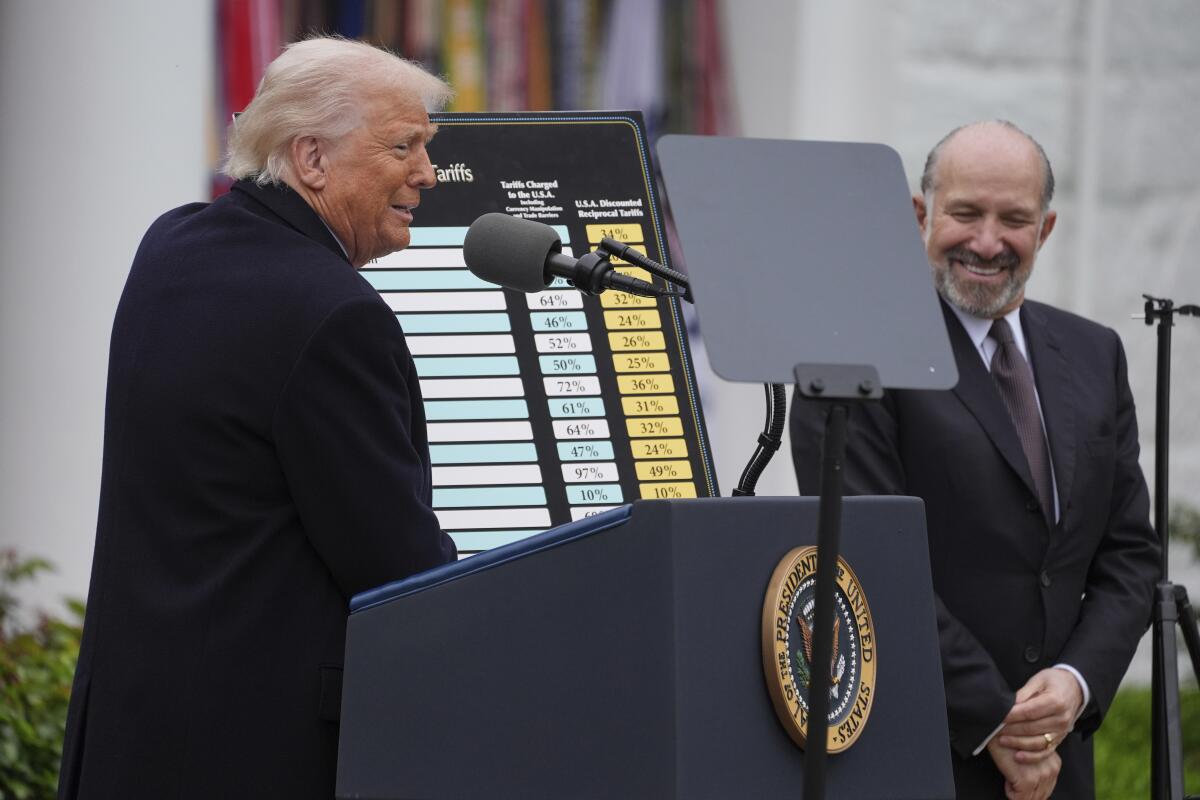Explaining the newest Wall Street craze — the ‘TACO’ trade

- Share via
Stock market investors don’t have much to cheer about in the second Trump term, except perhaps for a new and almost flawless trading strategy — the TACO trade.
The acronym, coined by Financial Times columnist Robert Armstrong, stands for “Trump Always Chickens Out.” (“Acronyms are very powerful, especially when they remind people of foodstuffs,” Armstrong told his colleague Katie Martin on an FT podcast.)
That his observation points to the way to profit from stock trades in an uncertain environment was underscored by the market’s response over the last few trading days to Trump’s threat to levy a 50% tariff on imports from the European Union. The tariffs were to begin on June 1, or nine days later.
Acronyms are very powerful, especially when they remind people of foodstuffs.
— Robert Armstrong, coiner of the TACO trade acronym
Trump issued that threat on Friday, May 23. That day the Standard & Poor’s 500 index fell more than 39 points, or 0.67%, and the Nasdaq index fell 188.53 points, or 1%.
Two days later, on Sunday, Trump announced that he would defer the tariff increase until July 9. On Tuesday, the first trading day following the Memorial Day holiday, stocks jumped back up. The S&P rose 118.72 points, or 2.05%, and the Nasdaq rose nearly 462 points, or 2.47%.
Get the latest from Michael Hiltzik
Commentary on economics and more from a Pulitzer Prize winner.
You may occasionally receive promotional content from the Los Angeles Times.
See how the TACO trade works? It’s a two-step process: Buy the dip — the lowered prices following a Trump tariff announcement — and sell at the higher prices after Trump’s inevitable chickening-out pushes stocks back up.
You’ll notice that the fall and rise weren’t symmetrical — the strength of the recovery was greater than that of the decline. That can’t be easily explained, except that it may suggest that hope is a stronger emotion than despair.
This ride on the Trump tariff roller-coaster wasn’t the first, and nowhere near the most violent. That trophy belongs to the period from April 2 through April 9, the “liberation day” tariff carousel.
Trump’s abrupt reversal on tariffs still leaves international trade policy in chaos.
It will be recalled that on April 2, Trump announced a raft of “reciprocal” tariffs on every U.S. trading partner, plus a couple of jurisdictions that were not trading partners, including with no human inhabitants at all. The new tariffs were set as high as 50%.
“The markets are going to boom,” Trump told reporters. Sadly, no. The stock market crashed upon Trump’s announcement, with the S&P falling nearly 5% the next day and the Nasdaq down nearly 6%. It was the worst day on the markets since a pandemic-triggered fall in March 2020.
Both indices continued to decline in subsequent days, as Commerce Secretary Howard Lutnick promised that “the President is not going to back off.”
Lutnick’s crystal ball was clouded, too. On April 9, Trump did back off, announcing a 90-day pause to provide time for individualized bilateral negotiations. That triggered a TACO relief rally: The S&P gained 474 points, or 9.52% — its third-biggest one-day percentage gain since World War II. The Nasdaq gained 1,857 point or 12.16%, its second-biggest one-day percentage gain ever.
Neither gain brought those indices back to where they had been on April 2, before Trump’s “liberation day” announcement, however. It’s also true that the downdraft and updrafts have even inspired suspicions that White House insiders with advance word of the announcements are trading stocks on the knowledge, though no such evidence has emerged.
Sen. Adam Schiff (D-Calif.) tweeted on April 9 that Trump’s “constant gyrations in policy provide dangerous opportunities for insider trading. Who in the administration knew about Trump’s latest tariff flip-flop ahead of time? Did anyone buy or sell stocks, and profit at the public’s expense?”
Investors at large haven’t fully gotten their arms around the TACO trade, which is why the markets continue to shudder with every new tariff announcement and recover with every reversal. There may be a residual concern that this time the tariffs will stick.
Trump plainly resents the sentiment underlying the acronym. “It’s called negotiation,” he said when asked about it at a news conference Wednesday. “That’s a nasty question,” he added. But it happens that the acronym isn’t the biggest embarrassment confronting his tariff policy: On Wednesday, the U.S. Court of International Trade invalidated most of Trump’s tariffs, including the April 2 levies, on grounds that he didn’t have the statutory authority to impose them.
Still, the in-and-out running of Trump’s tariff policies carries some important lessons for investors — and anyone else obsessing over Trump’s thought processes.
With his tariff ‘deals,’ President Trump leaves international trade relationships even more unsettled than before.
One is that Trump has turned Theodore Roosevelt’s maxim to “speak softly and carry a big stick” on its head: He speaks loudly and carries barely any stick at all. Another is a corollary to the first, which is that it may be inadvisable to panic over a short-term Trump-driven downdraft in the markets.
Money manager Ben Carlson made that point graphically on his Wealth of Common Sense website. “What if you panic sold right when things seemed the bleakest right before that crazy 10% up day in early April [that is, April 9] and then panic bought back in the next day?” he wrote.

Investors who stayed fully invested in the S&P 500 through the turmoil emerged with a gain of 0.7% on the year, through April 9, Carlson calculated. Those who panic-sold, missing out on the recovery, ended with a year-to-date loss of 8.1%.
Trump’s habit of acting through bluster has permeated much of his policymaking in his second term, not only on tariffs. His threats against universities and law firms sound horrific and determined enough to have frightened some of those institutions into making preemptive deals to keep him from following through. As I’ve reported, the capitulators haven’t bargained on Trump’s love for bullying weaklings.
Boeing already was suffering in its competition with Airbus before Trump started his tariff war. That won’t make things any easier for America’s top export company.
Some of Trump’s targets have cottoned on to his practice of letting bluster do the hard work of policymaking, rather than painstakingly drafting his policies so they’re legally and constitutionally bulletproof. They have come to understand that a full-frontal counterattack is likely to bear fruit.
That’s been evident in the lawsuits that four major law firms filed in response to Trump’s executive orders attacking them. Federal judges have granted three of the four firms summary judgment against the government; a judge’s ruling in the fourth case is pending.
The judges have focused on the fundamental feebleness of the executive orders, generally finding them to violate the firms’ 1st Amendment rights, and rights to due process and equal protection under the law, among other infirmities.
The most ringing critique of the Trump administration’s lawyering was issued Tuesday by Judge Richard Leon of Washington, D.C., who declared Trump’s executive order targeting the firm WilmerHale “unconstitutional ... in its entirety.”
Leon punctuated his order with, by my count, 27 exclamation marks, signifying his intense impatience with the quality of the government’s arguments in his courtroom. “The cornerstone of the American system of justice is an independent judiciary and an independent bar willing to tackle unpopular cases, no matter how daunting,” he wrote in the opening line of his order. “The Founding Fathers knew this!” (I’m not sure I’ve ever read a federal judge’s order that has even one exclamation mark, let alone 27.)
Trump and Vance claim that tariffs are paid by foreign companies and that economists are divided on the topic. They’re wrong on both counts
Trump’s tariff orders betray the same inattention to detail. They make no economic sense even on their own terms. They’re based on a fundamental misunderstanding of who pays the tariffs — they’re not paid by exporters or foreign regimes, as Trump maintains, but by consumers, making them a tax on Americans. They won’t achieve their stated goal of bringing manufacturing back to these shores.
Trump’s hair-trigger reversals, moreover, undermine any effect they might have had. That’s especially the case with the latest chickening-out — the European Union tariffs that lasted all of two weekend days — a period that Justin Wolfers, the witty economic commentator from the University of Michigan, calculated as “18% of a Scaramucci,” a jocular metric based on the 11-day reign of Anthony Scaramucci as Trump’s communications director in his first term.
All this underscores the utility of the TACO trade, as long as one has the emotional strength to stand pat during a Trump-inspired maelstrom.
But it doesn’t mean that after the round trip of tariffs-on-tariffs-off the economy is back to where it might otherwise have been or that they’re otherwise unimportant.
With confidence in U.S. economic growth shaken and an international trade system that has lasted since World War II — and that advantaged the U.S. more than any other country on Earth — thrown into upheaval for no detectable rational reason, there’s no telling about the long-term ramifications of Trump’s trade war.
All it means is that in the near term at least, the way to bet is that Trump will, indeed, chicken out. As he has been doing since Inauguration Day.
More to Read
Insights
L.A. Times Insights delivers AI-generated analysis on Voices content to offer all points of view. Insights does not appear on any news articles.
Viewpoint
Perspectives
The following AI-generated content is powered by Perplexity. The Los Angeles Times editorial staff does not create or edit the content.
Ideas expressed in the piece
- The TACO trade (“Trump Always Chickens Out”) exploits a recurring pattern where markets dip after Trump’s tariff announcements and rebound when he reverses course, allowing investors to profit by buying low and selling high. This strategy has proven effective during volatile episodes, such as the April 2025 “liberation day” tariffs and the May 2025 EU tariff threat, which triggered dramatic market swings followed by recoveries[3][4].
- Critics argue Trump’s tariff policies lack legal and economic coherence, citing court rulings that invalidated his measures for overstepping statutory authority and ignoring constitutional protections. Judges have repeatedly rejected their rationale, with one opinion dismissing an executive order targeting law firms as “unconstitutional in its entirety” and riddled with “infirmities”[3].
- The article emphasizes that tariffs function as a tax on U.S. consumers rather than foreign entities, contradicting Trump’s claims. It also highlights long-term risks to global trade stability and economic confidence, despite short-term market rallies driven by the TACO trade[4].
Different views on the topic
- Some analysts contend that macroeconomic factors like Federal Reserve policy, interest rates, and inflation—not Trump’s tariff reversals—are the primary drivers of market performance. They argue the TACO trade’s success is situational and less impactful than broader economic trends[1][4].
- Trump defends his tariff threats as legitimate negotiation tactics, dismissing the “TACO” label as a “nasty” mischaracterization. He frames reversals as strategic pauses for bilateral talks, asserting they strengthen U.S. leverage in trade disputes[1][3].
- Critics caution that relying on the TACO trade perpetuates market volatility and long-term uncertainty, discouraging stable investment. Others raise ethical concerns, such as potential insider trading by officials with advance knowledge of policy shifts[2][3].
Get the latest from Michael Hiltzik
Commentary on economics and more from a Pulitzer Prize winner.
You may occasionally receive promotional content from the Los Angeles Times.















